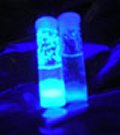I once interviewed renowned odor theorist Luca Turin who described one particular group of chemicals as being the “the Godzilla of smells”. He added that “You can’t believe how awful they smell…They make you vomit your guts out instantly.” Thankfully, I never came across them when I worked in a lab, but I’m sure he’s right.
Of course, the reason that I never happened upon these compounds during my lab days is that they have such an offensive odor that mosts chemists side-step them when designing their syntheses. That’s a shame though because they have several distinct benefits missing from the properties list of other ingredients.
Now, Michael Pirrung and Subir Ghorai, of the University of California at Riverside have found a way to make a new family of isonitriles. Their approach uses low-risk starting materials and they work well in the kinds of chemical synthesis reactions in which existing compounds are not quite so good. But, more to the point, these isonitriles don’t make you vomit. Instead, that have rather pleasant odors of soy, malt, natural rubber, mild cherry and even caramel, according to the team.
A bad smell is usually an indication that something won’t be too good to eat though. A mild cherry and caramel reaction sounds almost tasty, but I would seriously not recommend making it a lab-time snack.
More on isonitriles in the latest issue of JACS.
 Search engines spend huge amounts of money fine-tuning their search algorithms, but a report in the journal Complexus suggests that they might be wasting their time. Lörincz and colleagues argue that random results provide just as many positive hits on a given subject as even the sharpest algorithm available. You can read my interpretation of their findings in this article on
Search engines spend huge amounts of money fine-tuning their search algorithms, but a report in the journal Complexus suggests that they might be wasting their time. Lörincz and colleagues argue that random results provide just as many positive hits on a given subject as even the sharpest algorithm available. You can read my interpretation of their findings in this article on  Extracting oil from olives requires solvents and residues of halogenated solvent can sometimes leave a toxic taint in the product. European Union rules restricted the acceptable levels of these residues for the sake of public health but new sensitive and precise analytical procedures are needed to allow strict quality control and regulatory testing to be carried out.
Extracting oil from olives requires solvents and residues of halogenated solvent can sometimes leave a toxic taint in the product. European Union rules restricted the acceptable levels of these residues for the sake of public health but new sensitive and precise analytical procedures are needed to allow strict quality control and regulatory testing to be carried out. It has been thirteen years since Prasanna “AP” de Silva and his colleagues at Queen’s University Belfast published their first paper in the international science journal Nature, outlining how they hoped to convert small molecules into the kind of logical units that could carry out computations. In the September issue of Reactive Reports, we explain how this work has now led to the first practical application of logical chemistry and provided combinatorial chemists with a way to add a unique tag to potentially millions of molecules in parallel.
It has been thirteen years since Prasanna “AP” de Silva and his colleagues at Queen’s University Belfast published their first paper in the international science journal Nature, outlining how they hoped to convert small molecules into the kind of logical units that could carry out computations. In the September issue of Reactive Reports, we explain how this work has now led to the first practical application of logical chemistry and provided combinatorial chemists with a way to add a unique tag to potentially millions of molecules in parallel.